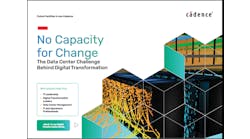In this edition of Voices of the Industry, Jason Green, Chief Technical Officer at Element Critical Data Centers and Essential Technology Centers, explores the concept of de-commmoditizing data center solutions and services, and the need for structure and infrastructure that’s specifically designed for colocation customers.
Jason Green, Chief Technical Officer at Element Critical Data Centers and Essential Technology Centers.
The technology that underpins our daily lives—allowing us to buy groceries, use ride sharing services, pump gas, make phone calls, store photos—is evolving at speeds that once seemed impossible. Our world is changing so quickly that even the data center technology supporting all those electronic necessities requires a frequent level of adjustment and evolution. An industry that barely existed a few decades ago has become amazingly changeable, alive, and exciting.
This lightning evolution presents a whole new magnitude of computing problems that need solutions. Faster and more potent technology requires faster, more potent data infrastructure. And there’s a direct relationship between the scale of that infrastructure, the power it consumes, and the cooling it requires—creating an ever-changing design target when it comes to data center construction.
Even so, most data centers are built within a set of prescriptive design criteria. On the surface, that makes sense. It’s not easy for an executive of a tech company to convince board members or backers that a new data center is worth the investment unless he or she can also tell them how many servers will live there and how they’ll be configured. And if that kind of information can be provided in advance, why shouldn’t everything else follow, no questions asked?
This type of mindset leads a lot of people in the industry—people who really care about their companies and their clients—to think about data infrastructure as a commodity. In fact, a colleague of mine has started comparing data centers in this mindset to a “ten pound bag of frozen chicken.” A bag of frozen chicken is the same wherever you buy it. So if you need one, it doesn’t really matter where you go, right?
The one-size-fits-all approach can curtail a company’s expansion when the challenges of new technology, different business uses of the IT equipment, and other developments are revealed down the road.
Of course, cooking is actually not like that at all, which is why the frozen chicken comparison is so smart. You might not know it, but frozen chicken now comes in a startlingly wide variety of flavors and cooking options. You can buy different chicken if you needed to cook it in an hour, if you wanted it pre-seasoned, or if you were on a low-sodium diet. Similarly, there’s nothing generic about each company’s unique mix of data and energy requirements. Signing on for a “bag-of-frozen-chicken” data center without considering those needs can lead to compounding consequences—for example, different-density server racks next to each other that are too hot or too cold because of uneven cooling needs, which can lead to poorly functioning equipment and unhappy clients. Even worse, the one-size-fits-all approach can curtail a company’s expansion when the challenges of new technology, different business uses of the IT equipment, and other developments are revealed down the road.
All this means that in this new age of data, what companies actually need instead of purpose-built cookie cutter data center buildings that will probably work is data center solutions, is structure and infrastructure that’s specifically designed with them in mind. A hedge fund might need high-density infrastructure for managing all its trading but beyond that only require basic services. A nearby oil company running heavy-duty mining applications that suck up a huge amount of energy would need a totally different set up in terms of heating and cooling. Why should anyone treat these companies as if they’re the same?
Solving this problem means undertaking in-depth discussions before any contracts are signed about how to correlate floor space, power, and cooling within a given budget—discussions that use customized design to prevent clients from feeling the pain of incomplete projects or equipment that’s starving for power. It’s a small investment that can save many future headaches.
These discussions are essential for smoothly executed projects in an industry where clients invest tens of thousands of dollars on a monthly basis and rely on operations to run without fail. But that it’s an undertaking that is so difficult—so deeply complex and technical—makes it all the more important to get it right. There’s too much on the line here to oversimplify.
Jason Green is Chief Technical Officer at Element Critical Data Centers and Essential Technology Centers.





